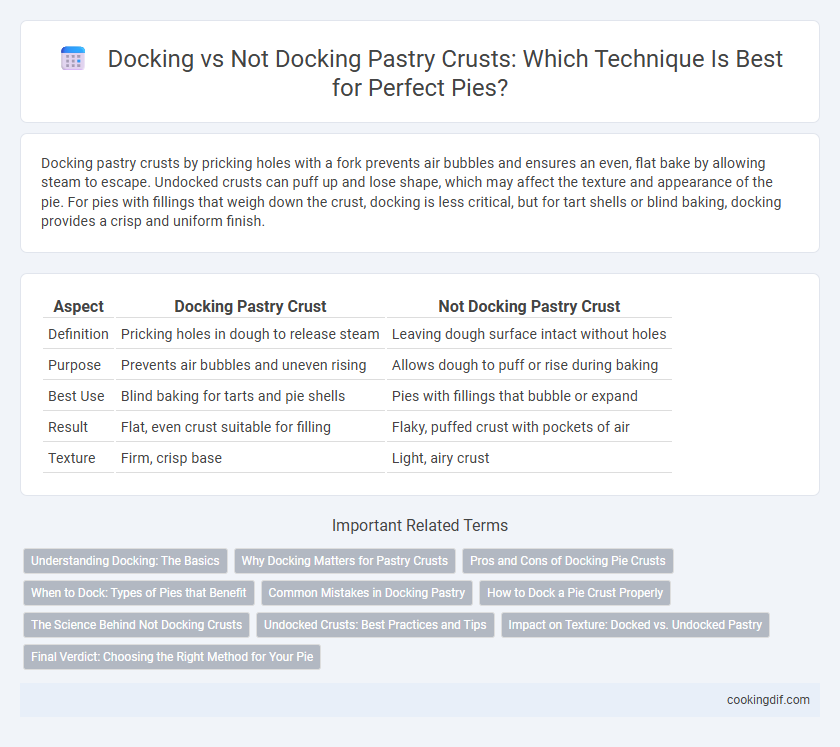Docking pastry crusts by pricking holes with a fork prevents air bubbles and ensures an even, flat bake by allowing steam to escape. Undocked crusts can puff up and lose shape, which may affect the texture and appearance of the pie. For pies with fillings that weigh down the crust, docking is less critical, but for tart shells or blind baking, docking provides a crisp and uniform finish.
Table of Comparison
| Aspect | Docking Pastry Crust | Not Docking Pastry Crust |
|---|---|---|
| Definition | Pricking holes in dough to release steam | Leaving dough surface intact without holes |
| Purpose | Prevents air bubbles and uneven rising | Allows dough to puff or rise during baking |
| Best Use | Blind baking for tarts and pie shells | Pies with fillings that bubble or expand |
| Result | Flat, even crust suitable for filling | Flaky, puffed crust with pockets of air |
| Texture | Firm, crisp base | Light, airy crust |
Understanding Docking: The Basics
Docking pastry crusts involves pricking holes in the dough to allow steam to escape during baking, preventing air bubbles and uneven rising. This technique is essential for achieving a flat, even crust in pies and tarts, ensuring an ideal texture and appearance. Not docking can result in puffed, misshapen crusts with inconsistent baking outcomes, especially when blind baking.
Why Docking Matters for Pastry Crusts
Docking pastry crusts creates small holes that allow steam to escape during baking, preventing the crust from puffing up or developing air bubbles. This technique ensures an even, flat crust ideal for both blind baking and filled pies, maintaining its shape and texture. Without docking, the trapped steam can lead to uneven cooking and an undesirable crust appearance.
Pros and Cons of Docking Pie Crusts
Docking pie crusts, which involves pricking the dough with a fork before baking, prevents air bubbles and ensures an even, flat crust, ideal for blind baking and avoiding uneven rising. However, not docking allows the crust to puff slightly, creating a flaky, airy texture preferred in some sweet and savory pies. Docking improves structural integrity and consistent baking, while skipping it can enhance texture but risks bubbling and uneven baking.
When to Dock: Types of Pies that Benefit
Docking pastry crusts is essential for pies with custard or cream fillings, such as pumpkin or custard pies, to prevent bubbling and ensure even baking. Fruit pies like apple or cherry, which have wetter fillings or top crusts, typically do not require docking because steam can escape through vents or lattice patterns. Savory pies with dense fillings also often benefit from docking to maintain a crisp, even crust during baking.
Common Mistakes in Docking Pastry
Over-docking pastry crusts can cause excessive shrinkage and uneven baking, while under-docking leads to air bubbles and puffing. Common mistakes include failing to prick evenly across the surface and pressing too deeply, which weakens the dough structure. Proper docking ensures controlled steam release, resulting in a crisp, flat crust ideal for pies.
How to Dock a Pie Crust Properly
To dock a pie crust properly, use a fork to prick evenly spaced holes across the surface, allowing steam to escape during baking and preventing bubbles or puffing. Focus on docking all areas, including edges and corners, without piercing too deeply to avoid tearing the dough. This technique ensures an evenly baked, crisp crust, especially crucial for blind baking or custard pies.
The Science Behind Not Docking Crusts
Not docking pastry crusts allows steam to build up during baking, which can create a lighter, flakier texture by lifting the dough layers apart. The trapped steam acts as a natural leavening agent, enhancing the crust's overall crispness and airiness. However, this method requires careful temperature control to prevent uneven bubbling or overexpansion, impacting the final pie crust structure.
Undocked Crusts: Best Practices and Tips
Undocked pie crusts allow steam to create natural pockets, resulting in a flaky, puffier texture ideal for fruit or custard fillings. To prevent excessive bubbling, place a pie shield around the edges to avoid burning and use a heavy-duty pie plate for even heat distribution. Chilling the dough thoroughly before baking enhances dough elasticity and minimizes unwanted expansion during baking.
Impact on Texture: Docked vs. Undocked Pastry
Docking pastry crusts creates small holes that release steam, preventing puffing and resulting in a crisp, even texture ideal for tarts and pie bases. Undocked crusts tend to puff and can develop air pockets, leading to uneven baking and a flakier but less stable texture. Choosing docking helps achieve a uniform, sturdy crust, essential for smooth fillings and professional pie presentation.
Final Verdict: Choosing the Right Method for Your Pie
Docking pastry crusts creates small holes that allow steam to escape, preventing bubbles and ensuring a flat, even surface in pies like quiches or tarts. Choosing not to dock is ideal for pies requiring a puffed or flaky texture, such as lattice-topped fruit pies, where trapped steam enhances browning and flakiness. For a perfectly baked pie, select docking when uniformity and crispness matter, and skip docking to achieve lightness and a golden, textured crust.
Docking vs not docking for pastry crusts Infographic

 cookingdif.com
cookingdif.com